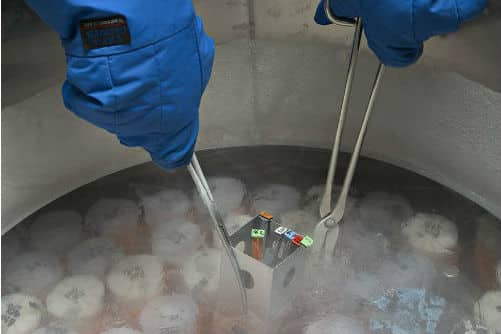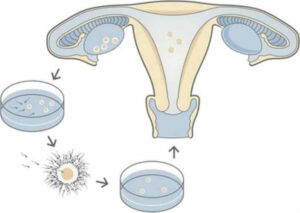Make sure you have read the article about In Vitro Fertilisation (IVF) before continuing.
Avant de poursuivre votre lecture, assurez-vous d’avoir pris connaissance du billet sur la fécondation in vitro (FIV).
The procedure to extract the eggs takes place via the vagina using a needle attached to an ultrasound sensor. This allows the professional to see the ovary, and more specifically, the follicles that contain the eggs to be extracted.
The needle will be directed inside the follicle that seems to show maturity characteristics to extract the liquid, including the eggs, inside it. If the woman has had her ovaries stimulated mildly or more severely, there may be between 2-10 eggs extracted.
This procedure is a delicate one, and the woman will be medicated using a sedative and local anesthesia to make sure she is calm, relaxed and drowsy.
The egg(s) will be placed in a healthy environment that will help fertilisation after adding between 50,000-10,000 high-quality mobile sperm. In the lab, the technicians will wait for fertilisation to take place. Between 16-18 hours later, the fertilisation for the creation of an embryo will be confirmed. This is why this is called artificial fertilisation because it takes place outside of the human body.
If the cause of infertility is associated with a low number or quality of sperm, the doctor can also directly extract sperm in the epididymis or testicle with a micro-pipette. Only the most vigorous, lively, healthy and mobile sperm will be kept to maximise fertilisation chances. They will then be added to the sample containing their spouse’s egg(s).
Since 1992, the IVF assisted reproduction can also occur using mechanical micromanipulations or microinjections. The quality sperm is then injected directly into the egg using a needle, which increases the fertilisation success rates. This technology is used when there are severe sperm issues, or if classic IVF doesn’t work.
After fertilisation, the doctor will wait 3-5 days before taking the formed embryo and introducing it into the woman’s uterus with a very flexible plastic catheter, which allows them to place it at the right location and ensure the best chance of nesting.
As needed, the doctor may conduct another test to evaluate the condition of uterine endometria to make sure it is receptive and increase the chances of successful implantation.
There may be several embryos available at the same time. Many doctors will prefer to use one embryo because there are fewer complications and risks associated with single pregnancies. Additionally, the Quebec assisted human reproductive program only covers IVF with one single embryo. However, it is possible that your doctor will transfer 2-3 embryos, but they have to justify their decision. This may occur due to the quality of the embryos, or for women around 40. The Quebec plan covers 3 stimulated (with medication) IVF cycles and six natural cycles.
Il se peut qu’il y ait plusieurs embryons disponibles à la fois. Bon nombre de médecins vont privilégier l’emploi d’un seul embryon à la fois puisqu’il y a moins de complications, moins de risques associés à une grossesse simple. De plus, le programme de procréation médicalement assisté du réseau public de la santé du gouvernement du Québec couvre seulement la FIV avec 1 seul embryon
IVF is pain-free, and after the procedure, she can go back to normal life with no need for added rest. She will be prescribed two medications which will help implantation. Two weeks later, she will do a pregnancy test.
The remaining good quality embryos can be frozen as part of a cryopreservation process to be used during subsequent cycles if necessary.
Since we know that infertility treatments are never 100% successful, it is crucial that the couple is solid, communicate effectively during the fertility procedures. Make sure you take the time to have fun, do projects together, travel, go out for dinner and keep the flame alive. This can help avoid conflict and separation.
Infertility is often seen as a loss of control over one’s life. You can’t plan a pregnancy like you can a marriage or the purchase of a new home. Couples that try to plan their lives around ovulation often end up feeling deception, failure, and mourning every month when the woman has her period. Making love on demand is not very interesting, and often adds stress and tension for the couple. People start feeling alone and don’t want to talk about it to avoid disparaging comments that some may make. It’s normal and very human to have difficulty dealing with this challenge.
You can talk to people who have gone through the same thing. It can help you express your own feelings more intimately without feeling judged or guilty. Has for psychological help if you need it. This can prevent distress, anxiety and depression. Asking for help is not a sign of weakness. Maintain positive energy and get rid of your negative feelings by doing yoga, meditating or by going to an acupuncturist. Adequate support will lessen the considerable stress associated with this adventure of trying to become parents. Luckily, most couples will end up building a family!
After several articles dealing with infertility, I think I have provided you with valuable information about the topic. While I didn’t go into all the tiny details, I believe you now have an excellent overview to help guide you through the challenges and stages you will face if you are currently unable to conceive.
I wish you all the best and hope your wish is granted soon.
Talk soon,
Marie
The Baby Expert



